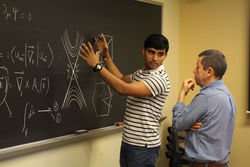Physicists tune the dynamics of exotic quantum particles

Physicists at West Virginia University have discovered a way to control a newly discovered quantum particle, potentially leading to faster computers and other electronic devices.
Weyl fermions, massless quasiparticles that were predicted to exist in 1930 by mathematician H. Weyl, were first detected in solid crystals by three independent research groups in 2015.
Soon after that experimental detection, WVU theoretical physicist Aldo Romero, an associate professor of condensed matter theory and computation, and physics PhD student Sobhit Singh, proposed a way to gain control over the dynamics of these quasiparticles: by creating them in pairs. Their theory, published in Physical Review B, was confirmed in an independently performed experiment published in Science Advances earlier this year.
"I think not only us but all the agencies in the U.S. have recognized that this research has a very bright future," Romero said. "The idea is not only being able to find novel materials but developing devices to use those properties."
These quasiparticles always appear in pairs. They can be moved and manipulated in a controlled manner when a coupling between the crystal symmetry and electric field is exploited. Singh compares the coupling to a dance.
"This is something like a dance, where each couple performs according to the beats, rhythm of the music and the steps of that specific dance style," Singh said. "In crystals, the interaction between the spin and orbital motions of electrons, or the spin-orbit coupling, plays the beat. An external electric field acts as music, and the crystal symmetries govern the possible motion of electrons. A pair of Weyl fermions forms the dancing couple."
The quasiparticles are unique because their spin gives them another degree of freedom in addition to electricity, making them more sensitive to many properties and allowing them to be manipulated in different ways.
"Because of this additional degree of freedom, we can couple the quasiparticles to other degrees of freedom. For example, we can apply light and see the response of it based on the spin. We can apply temperature and see what the changes will be with respect to the spin. We can apply a magnet and see the response with respect to the spin and things like that," Romero said. "Because we have this new degree of freedom, the spin, we have room to explore. We can explore all the possible combinations of those atoms to see which ones will be stable, and we can expand our research to realize new devices."
The emerging technology that utilizes the concepts of Weyl fermions is often referred as Welytronics. This technology promises to yield much faster and more energy efficient devices compared to the existing electronic devices.
"Everything we have, from light bulbs to cars to computers, is based on the electronic technology where we use massive and slow moving electrons. In the new Weyltronics technology, we utilize the novel features of massless Weyl fermions, which conduct electricity much faster and efficiently compared to the normal electrons," Singh said. "Since this technology is still at an early stage, it is hard to imagine all the possible devices that one can design using Weyl fermions. However, some major possible applications of this technology could include ultrafast switches, spin-transistors, logic devices, electric and magnetic field sensors and quantum computers."
More information: Sobhit Singh et al. Prediction and control of spin polarization in a Weyl semimetallic phase of BiSb, Physical Review B (2016). DOI: 10.1103/PhysRevB.94.161116
Tian Liang et al. A pressure-induced topological phase with large Berry curvature in Pb1−xSnxTe, Science Advances (2017). DOI: 10.1126/sciadv.1602510
Journal information: Physical Review B , Science Advances
Provided by West Virginia University





















